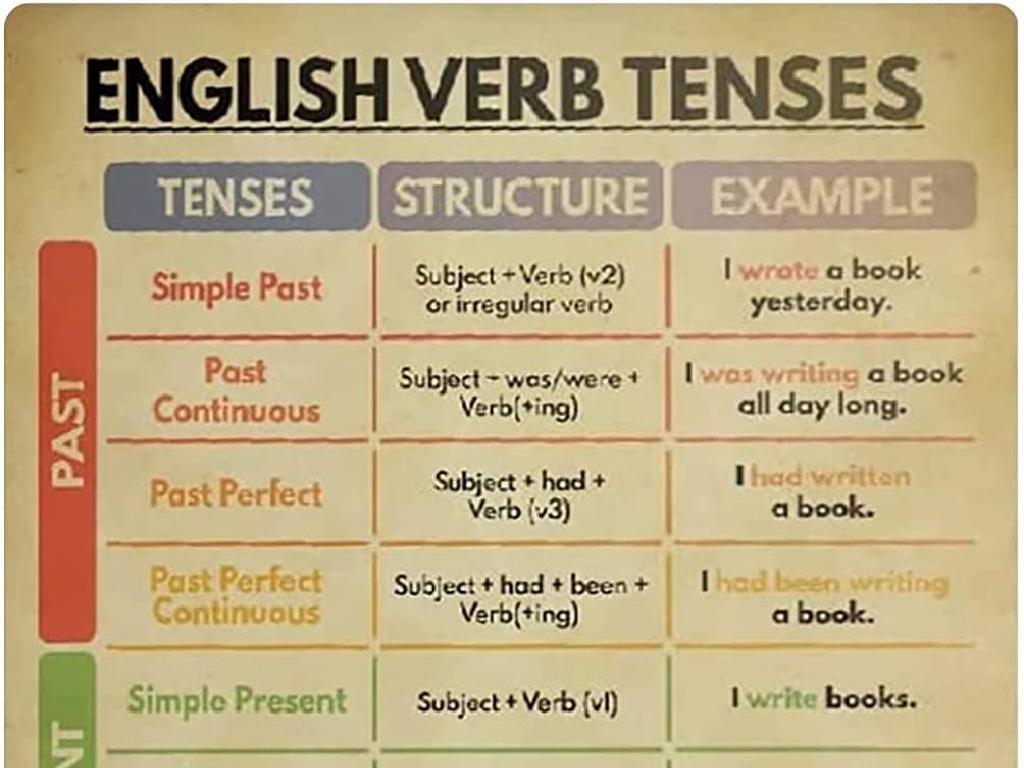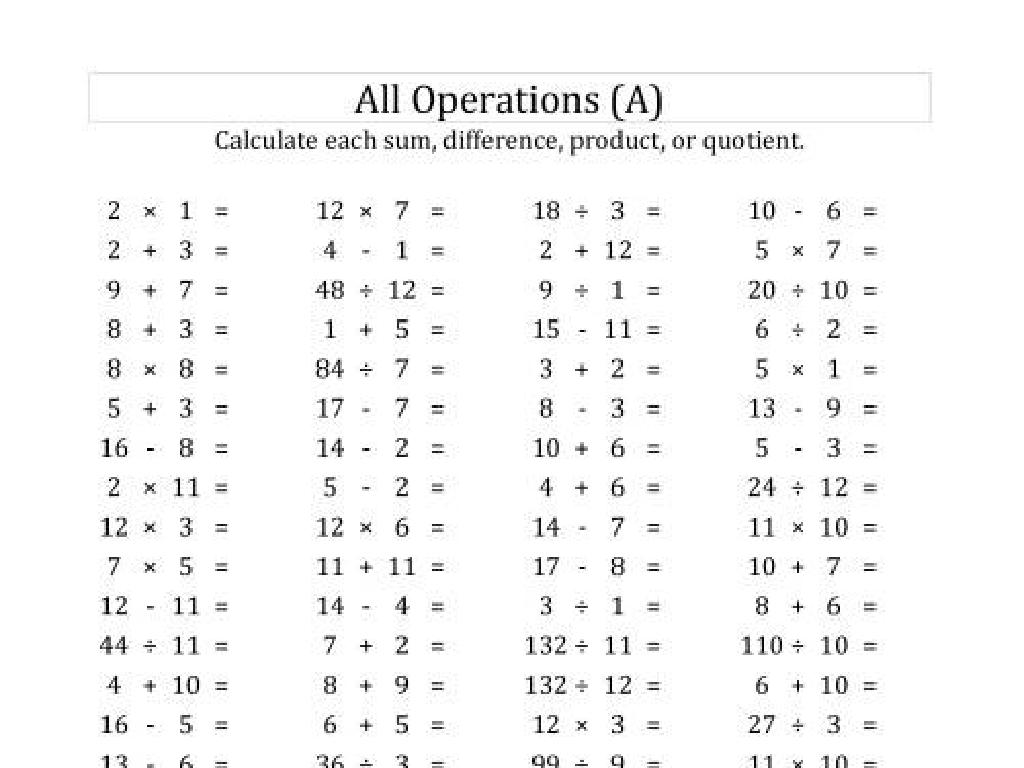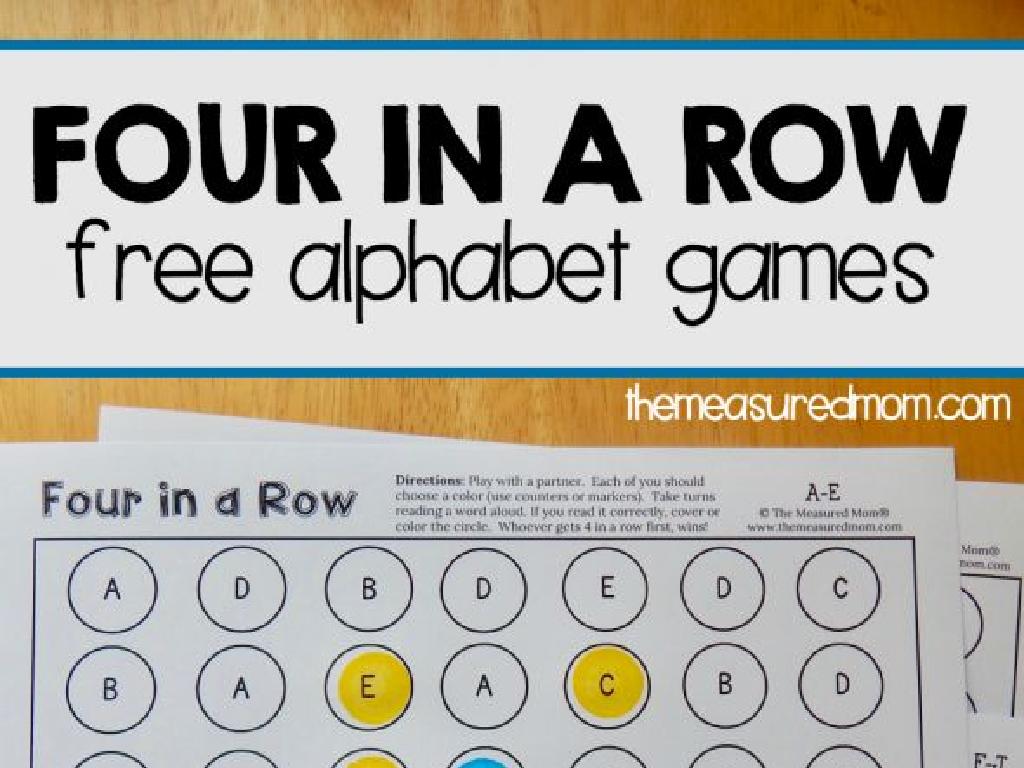Relate Addition And Subtraction Sentences
Subject: Math
Grade: Third grade
Topic: Mixed Operations: Addition And Subtraction
Please LOG IN to download the presentation. Access is available to registered users only.
View More Content
Mixed Operations: Addition & Subtraction
– Understanding mixed operations
Mixed operations use both addition and subtraction.
– Linking addition and subtraction
If you have 5 apples and gain 3 more, then lose 2, you’ve used addition and subtraction together!
– Real-life mixed operation examples
When shopping, if you add items to your cart and then remove some, you’re using mixed operations.
– Practice with mixed operations
|
This slide introduces the concept of mixed operations, which are mathematical problems that involve both addition and subtraction. Start by explaining that mixed operations are a combination of two basic math operations and they often occur together in real-life situations. Provide examples such as adding and then subtracting money while shopping, or gaining and losing points in a game. Encourage students to think of their own examples where they have used addition and subtraction together. The goal is to help students understand that these operations are not just isolated skills but are often used in tandem to solve everyday problems. In the practice section, include a variety of problems that require students to use both operations to find the answer.
Understanding Addition Sentences
– What is an addition sentence?
– An equation showing the sum of numbers
– Examples of addition sentences
– 3 + 4 = 7 or 5 + 2 = 7 show how numbers combine
– Creating our own addition sentences
– We’ll write sentences with numbers we choose
|
This slide introduces the concept of addition sentences to third-grade students. Begin by explaining that an addition sentence is a mathematical equation that shows how two or more numbers combine to make a sum. Use simple, relatable examples like adding apples or pencils to visually demonstrate the concept. Then, engage the students by having them create their own addition sentences using numbers that are familiar to them. Encourage them to think of real-life scenarios where they might add things together, such as toys or snacks, to make the activity more interactive and enjoyable. The goal is to help students understand addition as a way of combining quantities and to become comfortable with writing and interpreting addition sentences.
Understanding Subtraction Sentences
– What is a subtraction sentence?
– A math statement showing one value taken from another
– Examples of subtraction sentences
– 10 – 3 = 7 or 15 – 5 = 10, showing ‘taking away’
– Create your own subtraction sentences
– Use objects like pencils or fruits to make a sentence
– Practice with subtraction problems
|
This slide introduces the concept of subtraction sentences to third-grade students. Begin by explaining that a subtraction sentence is a way to show how much one number is reduced by taking away another. Use everyday examples, such as subtracting the number of apples eaten from a total, to illustrate this point. Encourage students to create their own subtraction sentences using items in the classroom or from their imagination. Provide practice problems for them to apply what they’ve learned, ensuring to include a variety of numbers. This activity will help solidify their understanding of subtraction as an operation and how it relates to addition.
Relating Addition and Subtraction
– Connection between addition and subtraction
– Addition puts together, subtraction takes apart
– Fact families and their relations
– Fact families use the same numbers to show how addition and subtraction are related
– Examples of related sentences
– 5 + 3 = 8 and 8 – 3 = 5 are related
– Understanding inverse operations
– Addition and subtraction are opposites; they undo each other
|
This slide aims to help students understand the relationship between addition and subtraction through the concept of fact families. Explain that addition combines numbers to make a new total, while subtraction takes away from a total to leave a smaller amount. Use examples of fact families to show how the same numbers can be used to create both addition and subtraction sentences that are related. Provide clear examples, such as 5 + 3 = 8 and 8 – 3 = 5, to illustrate this relationship. Emphasize that understanding how these operations are connected will help them solve problems more efficiently. Encourage students to create their own fact families and related sentences as practice.
Practice Time: Mixed Operations
– Solve mixed operation problems
– Use addition to check subtraction
– If 9 – 4 = 5, then 5 + 4 should equal 9
– Use subtraction to check addition
– If 3 + 6 = 9, then 9 – 6 should equal 3
– Share your answers with the class
|
This slide is for a class activity where students will practice solving mixed operation problems, specifically focusing on how addition and subtraction relate to each other. Students should use addition to verify the results of their subtraction problems and vice versa. This reinforces the concept that addition and subtraction are inverse operations. Provide several examples of mixed operation problems for the students to solve. After solving, they should use the inverse operation to check their work. Encourage students to discuss their methods and answers with classmates. This activity will help solidify their understanding of the relationship between addition and subtraction and improve their problem-solving skills.
Class Activity: Create Your Fact Family
– Learn about fact families
– Create your own fact family
– Choose 3 numbers and write 2 addition and 2 subtraction sentences
– Use addition and subtraction
– Remember, addition and subtraction are opposites
– Share with the class
|
This activity is designed to help students understand the relationship between addition and subtraction through the concept of fact families. A fact family consists of three numbers that are related by addition and subtraction. Start by explaining that in a fact family, you can add the smaller numbers to get the larger number, and you can subtract the smaller numbers from the larger number to get the other number. For the activity, have students pick any three numbers that work together and write down the corresponding addition and subtraction sentences. Encourage creativity and ensure they understand that the sum and the largest number in the subtraction sentences should be the same. After creating their fact families, students will share their sentences with the class, fostering a collaborative learning environment. Possible activities could include using number cards, dice to generate numbers, or drawing items to represent the numbers in their fact families.
Wrapping Up: Addition & Subtraction
– Review of today’s math concepts
– Why practice mixed operations?
– Helps with problem-solving skills
– Homework: Mixed operations worksheet
– Practice the addition and subtraction skills we learned today
– Bring any questions next class
– Ready to help you if you’re stuck!
|
As we conclude today’s lesson on relating addition and subtraction sentences, it’s crucial to emphasize the importance of practice in mastering mixed operations. The homework worksheet is designed to reinforce the concepts taught in class, such as understanding the relationship between addition and subtraction and how they can be used interchangeably to solve problems. Encourage students to attempt the worksheet independently but remind them that questions are welcome in the next class. This will help identify areas where they may need further explanation or support. The goal is to build a strong foundation in mixed operations, which are essential for future math success.






